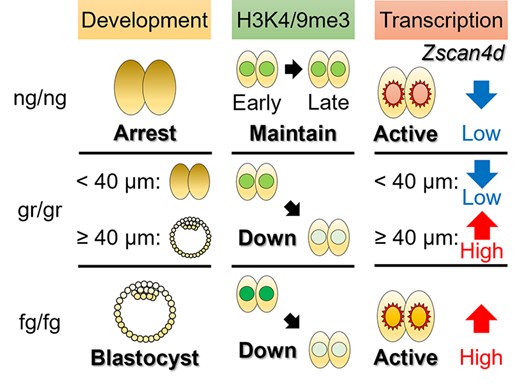-
Views
-
Cite
Cite
Wataru Yamazaki, Misako Higashiya, Yuriko Fujii, Megumi Yano, Takanori Oikawa, Shinsuke Seki, Effects of oocyte growth on development and histone modification during preimplantation in mouse parthenogenetic embryos, Biology of Reproduction, 2025;, ioaf114, https://doi.org/10.1093/biolre/ioaf114
Close - Share Icon Share
Abstract

Parthenogenetic embryos have two sets of genomes derived from fully grown oocytes (fg/fg) and are embryonically lethal by embryonic day 9.5 in mice. During growth phase, oocytes undergo epigenetic modifications including DNA methylation and histone modification. A previous study demonstrated that parthenogenetic embryos derived from nongrowing oocytes (ng/ng) were arrested at the eight-cell stage. However, effects of growing-stage oocyte genomes (gr/gr) on dynamics of development and histone modifications in parthenogenetic embryos have not been fully elucidated. Here, we investigated the development and dynamics of global histone modifications during preimplantation in mouse parthenogenetic embryos derived from ng and gr oocytes. Severe developmental arrest at the two-cell stage was observed in ng/ng embryos. Developmental competence in gr/gr embryos gradually improved depending on donor oocyte diameter. Global histone modification levels of H3K4/9me3 were significantly decreased from early-to-late two-cell stages in gr/gr and fg/fg embryos, but were maintained in ng/ng embryos. We also investigated the global zygotic de novo transcriptional activity; ng/ng embryos at the one- and two-cell stages showed comparable activity to that of fg/fg embryos. However, the transcript level of zygotic genome activation-related gene, Zscan4d, was significantly low in ng/ng embryos at the late two-cell stage. This study describes the characteristics of global histone modifications during early preimplantation in ng/ng and gr/gr embryos, suggesting that oocyte genomes during early growth phase lead to developmental incompetence and disrupted histone modifications during preimplantation in parthenogenetic embryos.




